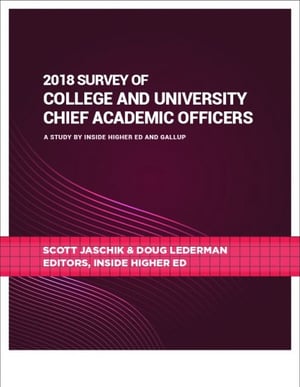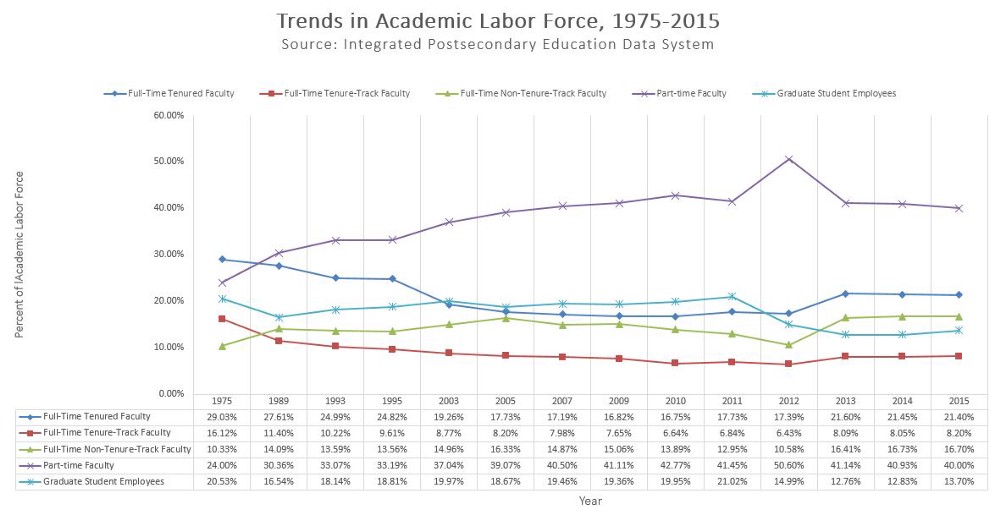How Hiring Full-Time Faculty can Increase Revenue
 Inside Higher Ed recently released their 2018 Survey of College and University Chief Academic Officers highlighting “The Pressure on Provosts.” While I agree with Inside Higher Ed Editor and Co-Founder Scott Jaschik that free speech, academic freedom, civic engagement, and campus culture were important issues this year, there is one structural issue buried in the article and findings of their report that deserves greater attention: an increasing reliance upon part-time faculty.
Inside Higher Ed recently released their 2018 Survey of College and University Chief Academic Officers highlighting “The Pressure on Provosts.” While I agree with Inside Higher Ed Editor and Co-Founder Scott Jaschik that free speech, academic freedom, civic engagement, and campus culture were important issues this year, there is one structural issue buried in the article and findings of their report that deserves greater attention: an increasing reliance upon part-time faculty.
Over the past five years, the number of chief academic officers who now believe that they are increasingly relying on part-time faculty has grown to 63 percent. At doctoral public institutions, 95 percent of chief academic officers now report relying significantly on non-tenure track faculty. Overall, only 8 percent thought they would become less reliant on non-tenure track faculty. These findings seem to be supported by data I collected that overlap this five-year period, but extends back 40 years.
In the figure below, over the past 40 years, the number of full-time, tenure-track faculty (red line) has declined by about 50 percent while the number of part-time faculty (purple line) has increased by 66 percent.

As many chief academic officers know, the decision to rely increasingly on part-time faculty has profound educational implications. In my previous research, I found that part-time faculty were significantly less likely to report engaging in experimental course content or teaching methods than their full-time colleagues. Other research has found that full-time faculty are more likely to be on campus, and spend about 50 percent more time per credit hour than their part-time colleagues. At public institutions, this also impacts student completion. Every ten percent increase in full-time faculty is associated with a 2.65 percent increase in the graduation rate.
Having been both a full- and part-time faculty member, my personal experience seems to mirror these findings. While I did my very best as a part-time faculty member and have stayed in touch with several of those students across the years, my part-time status was no substitute for the time and attention I was able to pay when I was a full-time faculty member.
From this “Pressure on Provosts,” two things seem clear: if chief academic officers are to rely increasingly on part-time faculty, they will need a better system, and the present reliance of part-time faculty need not necessarily be the case.
First, if chief academic officers decide they cannot rely on full-time faculty because of fiscal constraints, the sheer number of part-time faculty teaching the same course offerings can increase the need to coordinate room assignments and faculty by up to 300 percent. If you have a full-time faculty member teaching four courses, and you decide to hire four part-time faculty instead, you’ve effectively created 300 percent more work in terms of personnel management.
Haphazardly assigning new part-time faculty to sections and rooms when they are available to teach can create scheduling inefficiencies. One type of scheduling inefficiency occurs when part-time faculty are teaching off the normal meeting pattern. In my research at Ad Astra, I have found that among predominately public institutions, scheduling inefficiencies of this nature may slow down an institution’s graduation rate by as much as one-third of a percent. That might not sound like much, but it may mean scores of students not graduating on-time, paying tens of thousands more in tuition, and lost revenue for chief academic officers as only one course meets in a two-hour block when two could have met.
Second, it may not be necessary for chief academic officers to rely increasingly on part-time faculty. When I ask chief academic officers why they rely on part-time faculty, they may mention a certain expertise a part-time faculty member has or that an unexpected need arose and they had to fill a position with a part-time faculty member. Almost invariably, however, their response turns to the cost of full-time faculty. To be sure, chief academic officers are correct in that their full-time faculty are more expensive than part-time faculty because they are benefits eligible, which adds approximately 25–30 percent of the cost up front to say nothing of a long-term commitment by the institution to that faculty member.
What if full-time faculty were not a cost center for an institution but rather, a source of untapped revenue?
Recently, I began working with a colleague at Stephen F. Austin State University located in Nacogdoches, Texas. Stephen F. Austin University has an enrollment of about 12,000 students and is a Master’s public institution, which means that according to the Inside Higher Ed-Gallup survey, only about 6 percent of their peers’ chief academic officers believe that they will become less reliant on non-tenure track faculty.
Through an Ad Astra solution called Platinum Analytics, it became clear that there were six programs that had significantly more general education student demand than they were able to offer at the time. Basically, if Stephen F. Austin had offered 1,200 more seats to students in those six programs, Ad Astra estimated that they would have 1,200 students who would be able to fill them. This analysis led the institutional decision-makers, including their provost, to take a risk during fiscally challenging times by hiring 15 new, full-time faculty members to meet that demand. In the end, those 15 new, full-time faculty taught 52 new sections. 1,268 students took those courses, and Stephen F. Austin generated an additional $213,098 dollars in margin after paying their new full-time faculty. These new, full-time faculty helped generate 5,604 new student credit hours and a 3,000-student credit hour increase over the prior year. The institution estimates that this group of faculty will end up generating almost $1,500,000 in net new margin (revenue) over the academic year.
Earlier this month, John Calahan, my colleague at Stephen F. Austin and I presented this research at the American Association of State Colleges and Universities Winter Affairs Conference. To view that presentation.
On Thursday, February 22 at 2.00 PM Eastern, Inside Higher Ed co-editors Scott Jaschik and Doug Lederman will present a free webcast where they will discuss these and other findings in greater detail. I have attended their webinars in the past and always find myself walking away with a few additional insights. If you would like to register, you may do so simply by clicking here.



